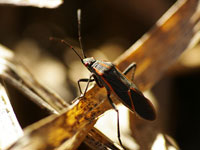Box Elder Bugs |
 Anyone living near boxelder trees is probably familiar with the distinctive black and red boxelder bug. These bugs are generally harmless but can become a nuisance when found in great numbers, particularly in late fall and early spring. DamageBoxelder bugs cause little damage to trees. They are harmless to humans, pets, and homes, but do invade homes in the winter which can be a nuisance. The most bothersome thing about these bugs is that they tend to leave brown spots on walls and windowsills that can be difficult to remove. The bugs themselves are gentle and will not harm humans even when handled. Although they do have biting mouth parts, they rarely bite humans and do not have venom. They are not poisonous if accidently eaten, although they are said to be bad tasting and they emit an unpleasant odor when squished. More Boxelder Bug FactsBoxelder bugs are in the order Hemiptera. Most bugs in this order are considered good bugs, meaning that they feed on other insects that are nuisances. The boxelder bug is not a predator like other Hemipteras but feeds on plants, mainly boxelder seed pods. The three life cycle stages of boxelder bugs are egg, nymph, and adult. After hatching, the nymph slowly metamorphoses into an adult. It lays its eggs in bark of the boxelder tree or other protected places. For the most part, boxelder bugs are harmless. They often invade homes over winter but cause no real damage to homes, people or even the box elder trees they feed on. |
FREE QUOTE
Let's Get Started...
Save 20% By Scheduling Online...
Address
 Website Powered by BannerOS. Your Business Energized!
Website Powered by BannerOS. Your Business Energized!





